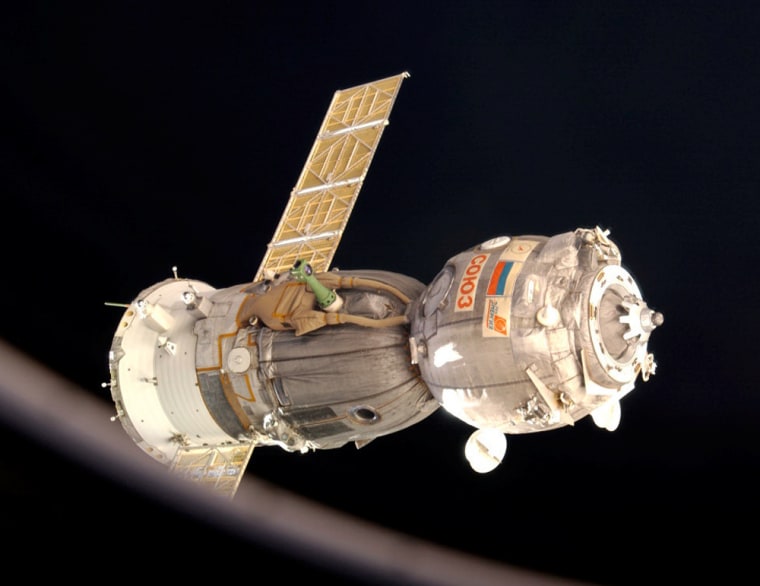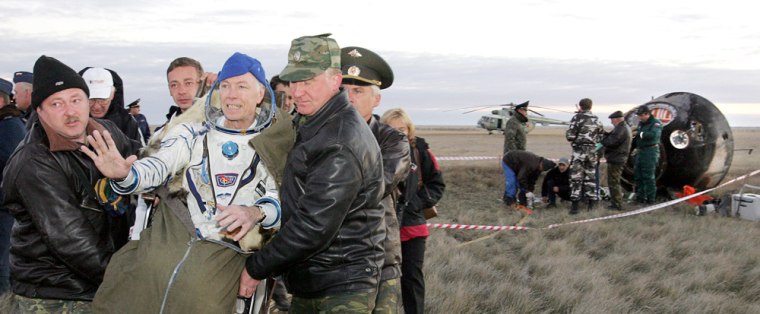Russia’s Mission Control endured a brief but private scare during this week's return of a Soyuz spacecraft from the international space station with three riders aboard, those familiar with the flight now say.
As the Soyuz descent module headed back to Earth, instruments indicated that air was leaking out — the same kind of failure that killed three cosmonauts in June 1971 on their way home from the world’s first space station, Russia's Salyut 1.
Since that tragedy, all passengers aboard Soyuz spacecraft have worn pressure suits during such mission-critical phases. Had Monday’s air leak been severe enough, the suits would have saved the men’s lives.
Cosmonaut Sergey Krikalev, the just-returned veteran Russian space traveler who had been the space station's commander for the past six months, discussed the problem openly during a Moscow news conference on Thursday.
“We had certain problems with pressurization before undocking,” Krikalev said. He added that there had also been problems with the craft’s airtightness during the descent: “In principle this was an anomalous situation of medium complexity. ... In fact, it was a fairly serious situation.”
Krikalev was commander of the Soyuz spacecraft for the descent and landing. He was accompanied by NASA astronaut John Phillips, who had been his crewmate on the six-month-long Expedition 11 aboard the station, and by millionaire space passenger Gregory Olsen, who had purchased his 10-day sojourn to the station and back commercially.
NASA refers to anomaly
NASA’s “On-Orbit Status Report” on Thursday contained a brief reference to the anomaly. The space agency said Russian officials “are investigating a slight pressure drop of the Soyuz TMA-6 spacecraft's atmosphere at the time of undocking, reported by the crew via radio. Since no telemetry could be received during the usual time of plasma blackout, data stored in the Soyuz descent module's recorder are being awaited.”
Other NASA sources said it remained to be seen whether the air leak was real, or whether there was only a failure in the pressure sensor. The sources discussed the problem on condition of anonymity because they weren't cleared to make official comment.
In Houston, NASA spokeswoman Kylie Clem told MSNBC.com that the Russians had informed NASA of the leak at the weekly meeting of the Mission Management Team on Thursday. "They have the flight data recorder returned to Moscow," she said, and a special commission will report preliminary results next week.
A real pressure leak, apparently the first in more than 30 years, would raise questions about the airtightness of the Soyuz TMA-7 spacecraft that was launched Oct. 1 and is currently docked to the station as a landing vehicle for the space station's current crew members, William McArthur and Valery Tokarev.

The full Soyuz spacecraft consists of a descent capsule, an orbital habitation module and a service module. During the return to Earth, the descent module, with up to three crew members inside, separates from the other two components.
Chris Kridler of the newspaper Florida Today reported Monday that “mission controllers in Russia had a scare when they lost communications with the Soyuz as its three modules separated,” and that “controllers repeatedly called out to the crew, then had Tokarev [aboard the station] describe his camera view of the glowing ship with inconclusive results.”
Although loss of communications is normal during the most fiery phase of the spacecraft’s atmospheric entry, the anxiety in the voices from Moscow may have been based on their awareness of the potential cabin depressurization.
Further details emerge unofficially
A more detailed account of the incident was provided via e-mail from another NASA worker who requested his name not be used.
“Undock occurred about 6 minutes late because of a larger than expected pressure drop when performing the leak check between the descent and habitation modules of Soyuz,” he related. “Moscow eventually decided that the leak check was nominal considering oxygen consumption and carbon dioxide removal.”
After separation and the firing of the craft’s rocket engine, the problem returned. “Pressure decay was also noticeable during descent,” he said, with pressure falling 12 percent.
“That's where Moscow told the crew to start cabin atmosphere repress[urization] with [oxygen]”. This seems to have worked, because once voice communication was restored, the cabin pressure was halfway back to normal. Russian officials reported that they had no idea “why the decay happened” but would be examining on-board recorders, the worker said.
When one cosmonaut was asked about the incident this week during a visit to the United States, he said the entire incident may have been a "possible instrumentation problem," another source told MSNBC.com. The cosmonaut was reportedly reluctant to talk further about the problem.
Ghastly space precedents
On at least three previous occasions, breathing problems during descent threatened the lives of returning space crews, so any alarm felt in Moscow over this latest incident would be entirely understandable.
In June 1971, cosmonauts Georgy Dobrovolksky, Vadim Volkov and Viktor Patsayev suffocated during the return from their pioneering three-week visit to Salyut 1. As the spacecraft jettisoned unneeded modules prior to hitting the upper atmosphere, a pressure equalization valve intended for activation much nearer to the ground was jarred open. Over the next minute — as the crew desperately tried to locate and stop the leak — all the cabin air was released to space.
Their Soyuz 11 spacecraft landed on autopilot, and recovery crews, puzzled but not alarmed over the lack of radio communication, rushed to open the hatch. The inert bodies of the three men were quickly extracted and resuscitation was attempted, but to no avail.
In 1975, during the landing of the last Apollo spacecraft, a procedural error caused by communications confusion led to noxious gas from the capsule’s thruster system being sucked into the cabin, almost incapacitating astronauts Thomas Stafford, Deke Slayton and Vance Brand. Aside from the threat of poisoning from the chemical, the crew came close to losing consciousness and not being able to deploy the capsule’s parachute system — which would have been a fatal development.
In 1977, during an emergency night landing after a botched docking at a military space station, cosmonauts Vyacheslav Zudov and Valeriy Rozhdestvenskiy landed by bad luck on a salt lake in their desert recovery zone. Fouled parachute lines turned the bobbing capsule on its side so that its air vents were blocked.
The recovery team was ill-equipped for cold-weather water operations, and it took half a day of frantic effort to retrieve the capsule. Space officials assumed that the cold and suffocation must have killed the two men trapped inside. When the capsule was finally beached, workers gingerly opened the hatch and expected to find dead bodies. Instead, the cosmonauts waved weakly to them — barely alive.
